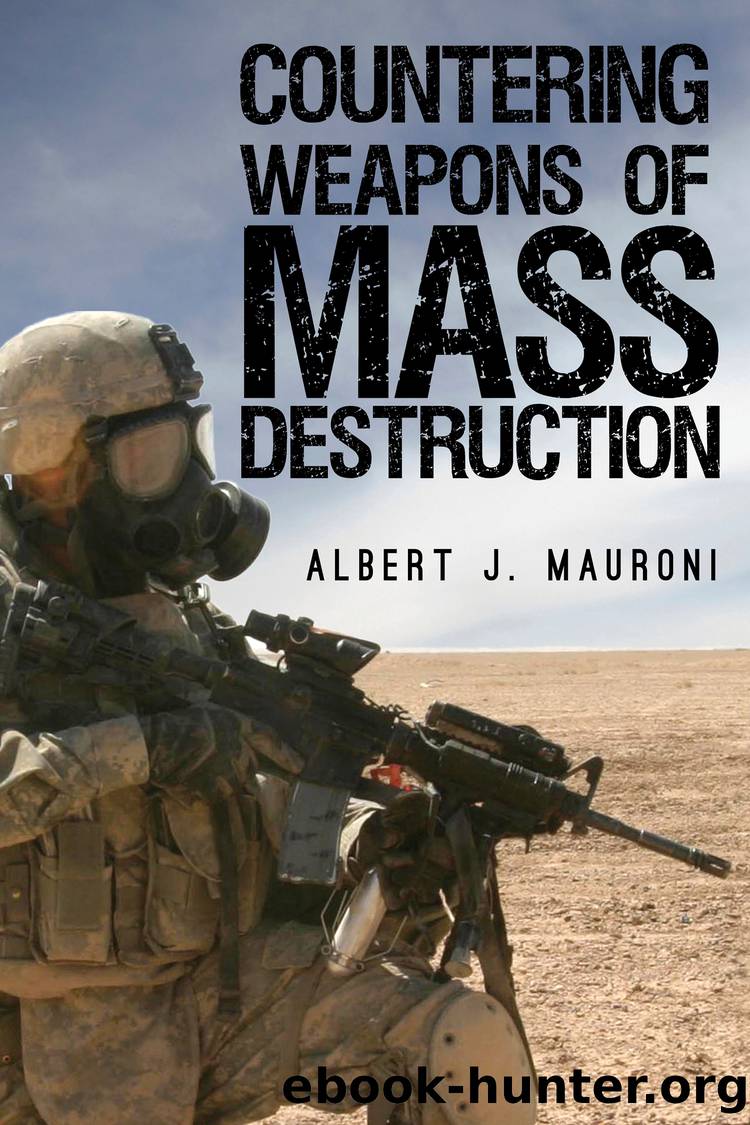Countering Weapons of Mass Destruction by Mauroni Albert J.;

Author:Mauroni, Albert J.; [Mauroni, Albert J.]
Language: eng
Format: epub
Publisher: Rowman & Littlefield Publishers, Incorporated
Published: 2016-08-15T00:00:00+00:00
7
The Need for a Counter-WMD Strategy
Isnât it a little late to be worrying about international conventions? Is nerve gas any worse than getting your head blown off by a precision-guided laser missile? Frankly, itâs a nuance thatâs lost on me. Besides, we didnât do anything.
âJohn Cusackâs character, Hauser, in War, Inc., 2008
Given the past few chapters discussing the history of this policy area, I will make the case that we need to change the U.S. governmentâs postâCold War approach to countering WMD programs. In particular, the fixation on the term WMD creates conditions in which the majority of political and defense analysts debate contemporary security concerns without addressing WMD issues. In addition, the term divides policy makers from the operators who are supposed to address this threat. This chapter will outline a new perspective that presents a comprehensive and integrated strategic approach to countering unconventional weapons development and use by adversary nations and substate groups. We need a coherent national direction and an executable approach that outlines policy objectives, explains which government agencies are responsible for particular aspects, and resources the means by which these efforts are to be executed. I suggest that we do not need a single âstrategyâ in the sense of past national and DoD guidance on countering WMD that has been presentedâthese were political narratives for a general audience, lacking critical details on implementation or measures by which to judge success and not grounded in the broader strategic discussion. A better vehicle may be a presidential directive on countering WMD that aligns the tools of government power toward discrete objectives, followed by a strategic plan and performance plan developed by each executive agency that identifies how the work would get done.
The challenge in developing this new direction is twofoldâwe have an unclear definition of WMD and too many conflicting, poorly written strategies. The very term WMD causes confusion and misdirection of resources because it covers just about every CBR hazardânatural and man-madeâto include effects from industrial chemicals, natural diseases, and high-yield explosives. The arms-control community will not let us abandon the Cold War term WMD because it wants to define programs to contain and deter chemical and biological weapons development and use along the same lines as those efforts intended to contain and deter nuclear weapons development and use. And thatâs okay, if only one could limit the discussion to regulating or monitoring nation-state WMD programs, but itâs difficult to do so. As discussed in chapter 2, people want to expand the use of the term WMD for their own personal or professional reasons, but that inherently reduces the value of the term and clouds, rather than clarifies, policy execution. Thus, we do not need a single general strategy to counter WMD as much as we need a clear policy direction and consistent oversight to enact multiple government efforts that lead to discrete capabilities that deter NBC weapons development, counter NBC weapons use, protect against CBR hazards, and respond to CBR terrorism.
The proliferation of national
Download
This site does not store any files on its server. We only index and link to content provided by other sites. Please contact the content providers to delete copyright contents if any and email us, we'll remove relevant links or contents immediately.
| Biological & Chemical | Conventional |
| Nuclear |
The Radium Girls by Kate Moore(10923)
The Templars by Dan Jones(4198)
100 Deadly Skills by Clint Emerson(4091)
Rise and Kill First by Ronen Bergman(4026)
The Doomsday Machine by Daniel Ellsberg(3742)
The Rape of Nanking by Iris Chang(3530)
Killing England by Bill O'Reilly(3466)
Hitler in Los Angeles by Steven J. Ross(3450)
Stalin by Stephen Kotkin(3094)
12 Strong by Doug Stanton(3064)
Hitler's Monsters by Eric Kurlander(2740)
Darkest Hour by Anthony McCarten(2655)
Blood and Sand by Alex Von Tunzelmann(2615)
The Art of War Visualized by Jessica Hagy(2424)
Hitler's Flying Saucers: A Guide to German Flying Discs of the Second World War by Stevens Henry(2305)
The Code Book by Simon Singh(2222)
The Second World Wars by Victor Davis Hanson(2140)
Babylon's Ark by Lawrence Anthony(2077)
Tobruk by Peter Fitzsimons(2068)
